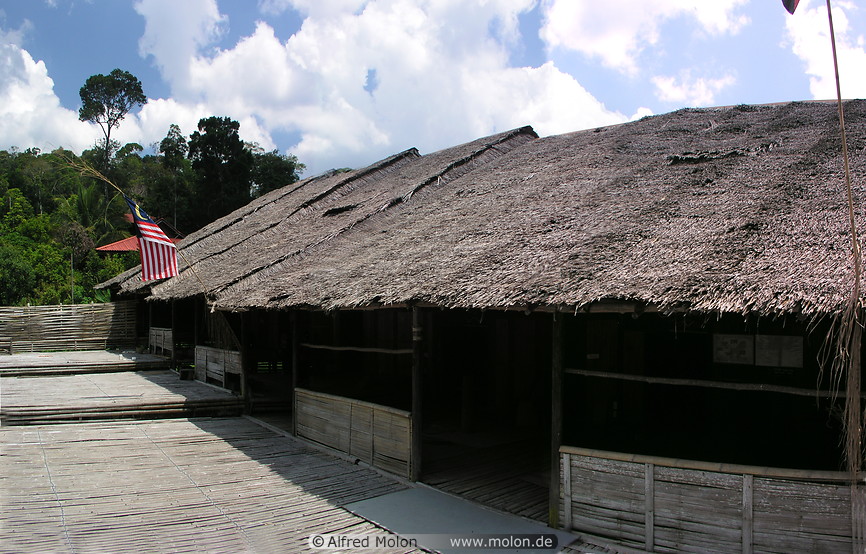Bidayuh Longhouse.
Welcome to the Bidayuh Longhouse! It's a bamboo galore! Bamboo carvings, plumbing, musical instruments, bridges, flooring, walls. The gongs and war drums will welcome you to the Barok - the round head-house. Get caught up in the rhythm of rural activity. Sugar cane crushing, paddy pounding, and not to mention winnowing rice too.
The Bidayuh race, accounting for 8.4% of Sarawak's population live mainly within the catchment of the Sarawak and Sadong rivers. Early European travelers gave them the name “Land Dayaks” because they lived in the steep limestone mountains, near the watershed area of West Sarawak, in what was then Dutch Borneo.
Many Borneo natives live in longhouses, in effect, a row of dwellings and a village street under one roof. The Bidayuhs, a group comprising the Jagoi, Biatah, Bukar-Sadong, Selakau and Lara peoples of West Sarawak, built their houses in mountain fastnesses, tacked to a steep hillside like a gigantic staircase. This was partly for protection against marauding enemies, partly for access to pure, fresh water.
The terrain occupied by the Bidayuhs inspired them to construct ingenious systems of gravity-fed water supply. A little river is dammed at a distance above the longhouse, and the water carried to the dwelling in bamboo conduits.
Iban Longhouse.
The Iban race, once known as “Sea Dayaks”, built their longhouses to last 15 to 20 years, or, until the farm land in the surrounding area was exhausted. Then they packed up their goods and chattels and moved inland, upriver, along the coast, wherever fresh farm lands looked promising. About one-third of all Sarawakians are Iban; while some of them live in towns or individual houses, a large number still prefer longhouses.
Several doorways lead from the outer to the inner verandah under the roof. This is the village street of the longhouse; the individual family rooms or “doors” front the common walkway. A casual visitor is invited to sit down on a mat here for a chat with the longhouse elder; family members enter through their relatives' doors and make themselves at home.
A traditional longhouse is built of axe-hewn timber, tied with creeper fibre, roofed with leaf thatch. It is nearly always built by the bank of a navigable river, and the visitor approaches it from the boat jetty. He climbs up a notched log that serves as a staircase and finds himself on the open verandah face to face with a scene of community and domestic activity.
Penan Hut.
Penan specialty is the manufacturing and accurate use of blowpipes. A wood beam of adequate length is fixed in a drilling platform, and then bored through patient manual labour. The pipe is trimmed by axe and knife, and finally polished. The bore is smoothed and ground by pulling lengths of rattan through it.Watch blowpipe making or try blowpipe shooting with the Penans, the last of the hunters and gatherers - the forest nomads. Blowpipe ammunition is a softwood plug tipped with a hardwood dart. Blowpipe poison, carefully dosed to suit the prey, is made from the sap of the Upas tree (Antiaris toxicaria).
The shy nomadic people of the jungle, the Penans, live in the dense virgin jungles of Central Borneo, among some of the State's most valuable timber resources. Some are 'coming out' and learning to farm the land, others still prefer their roaming life-style.
Penan shelters are quickly constructed to last for a few weeks or months. They are sited near a good stand of wild sago trees, the Penan's staple food; after this has been used up, the family moves on.
Orang Ulu Longhouse.
The Kayan, the Kenyah, the Kelabit, the Lun Bawang and the other minor tribes. These are the Orang Ulu, gentle and graceful people - as reflected in their songs, music and dances.
Sit on the verandah of the Orang Ulu Longhouse nest with the friendly craft-ladies as they do their intricate beadwork whilst in the background, floats the melodiously haunting tune of the sape, their stringed musical instrument. Other sights of interest are the art of body tattooing, Parang Ilang, their fighting sword, Klirieng, their burial pole (totem pole).
Orang Ulu, “up-river dwellers”, is a useful if vague term to describe the central Borneo people living in Sarawak. Accounting for 5.5% of the total population, the Orang Ulu comprises the Penan, the Kayan and Kenyah, living in the middle and upper reaches of Sarawak's longest rivers, the Kelabit and Lun Bawang groups in the highlands proper.
In the past, the orang Ulu were famous throughout the region as sword-smiths. They extracted iron from the ore found in their area, they forged it into excellent blades which they tempered in the cold mountain streams.
Traditionally, an Orang Ulu longhouse was built to last. Many of these people practise settled agriculture, and have developed rice field irrigation to a fine art. This makes the search for new farmlands unnecessary. The solid ironwood houses are designed to last for many generations.
Norfazelin Bakar,
1101108092.
1101108092.



















nice information provided by the blogger and nice thought. thank you for sharing Jet printed entrance mats.
ReplyDeleteGreat read such an article in 2020 about rugs and mats time
ReplyDelete